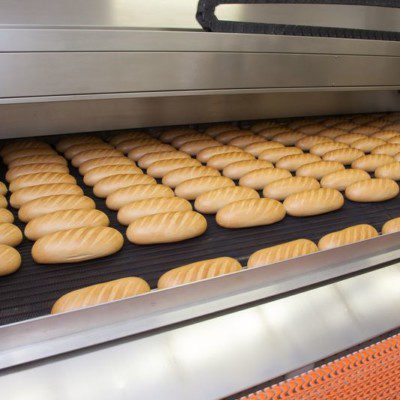Origin
Baking parameters control has become a common practice as more high-speed bakeries serve bigger bread and bun markets. Advances in instrumentation and automation technology made it possible to control and regulate on a real-time basis variables. For example, temperature in multiple-zone ovens and air flow throughout continuous convection ovens.
How they work
Various chemical and enzyme-mediated reactions and subsequent physical changes to the product during baking are a result of the interaction of time, temperature, heat transfer and product moisture migration.1,2
Temperature of baking chamber
Temperature in oven zones determines the rate of heat transfer from and to the product. So that’s also the timing of thermal events such as yeast kill, starch gelatinization, protein denaturation, moisture extraction and crust browning. All these events ultimately determine the quality of bread. Baking temperature is perhaps the one parameter that is most understood and easiest to control.
As a rule of thumb, the higher the temperature, the shorter it takes for the product to fully bake to its geometric center.
Air velocity
The term air velocity implies the flow of hot air inside the baking chamber, usually expressed in m/sec or ft/min. In a convection oven, air velocity directly controls the amount of heat delivered to the product. It also influences the baking time, weight loss as a consequence of water extraction, and color of baked products.
Even distribution of airflow across the width of the oven chamber is vital for even heat distribution and optimum product bake. The higher the air velocity, the faster the product loses water and hence the shorter the bake time needed to achieve full bake.
Heat flux
Heat flux is the amount of energy transferred per unit area per unit time from or to a surface. It has three components: radiation, convection and conduction. It can be expressed in Btu/hr·ft2 or W/m2. Both the total amount of heat flux and the ratios of the three components influence the baked product’s quality.
This parameter is probably less commonly measured. It’s controlled on a real-time basis in the normal operation of a high-speed oven. However, it is very important during the oven design phase, such as prior to equipment onsite commissioning.
In pan bread production, convective and radiant heat is absorbed by the pan, which also serves as the conduction mechanism to the product. It can be said that heat flux is a direct consequence of how the heating mechanisms work. For example, ribbon burners in direct gas-fired ovens.
Processing time
Bake time is governed by the timing of thermal events and baker’s experience. It should only be established via thermal profiling and not by how the crust looks. In continuous ovens, bake time is controlled by conveyor speed.
Humidity
Oven humidity influences moisture migration from the product’s interior to its surface and thus, evaporation. Drier oven conditions promote faster water extraction due to increased mass transfer moisture gradient.
Humidity inside the baking chamber can be expressed as % moisture by volume or as absolute humidity mass ratio (lb water/lb dry air or kg water/kg dry air).
Application
By monitoring baking parameters, bakers can tell if their oven is operating as expected. Oven auditing can be performed using thermal profiling equipment with sensors that are capable of measuring baking parameters.
In most high-speed bakeries, only temperature and time are monitored and controlled on a real-time basis. Human machine interface (HMI) screens are usually placed next to the oven for operators and plant engineers to modify temperature profile per zone, compare actual vs set point temperatures, check if burners are lit and observe other process variables, such as air/gas pressure in the combustion system.
References
- Peñaloza-Espinosa, J., et al. “Effect of Baking in Product Quality and Baking Ovens.” Advances in Heat Transfer Unit Operations: Baking and Freezing in Bread Making, CRC Press, Taylor & Francis Group, LLC, 2017, pp. 189–212.
- Lucas, T. “Baking.” Bakery Products Science and Technology, 2nd edition, John Wiley & Sons, Ltd, 2014, pp. 335–354.

